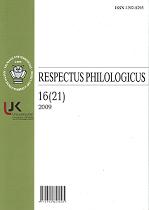RECEPCIJOS TEORIJA IR SKAITYMO PRAKTIKA
RECEPTION THEORY AND PRACTICE OF READING
Author(s): Aleksandras KrasnovasSubject(s): Language and Literature Studies
Published by: Vilniaus Universiteto Leidykla
Keywords: recepcijos teorija1; literatūros kūrinio konkretizacija2; skaitymo procesas3; hermeneutinis ratas4;
Summary/Abstract: The article analyses one of the key categories in reception theory, i.e. concretization of a piece of literature in the consciousness of the receiver. It shortly presents the ideas of one of the founders of this theory Roman Witold Igarden and his concepts of schematism and concretization of a piece of literature, which are based on the assumption that all things and phenomena of the world, expressed in the text by more or less abstract words, are concretized and visualized in the consciousness of the reader, and the features of concrete things are attributed to them. However, the practice of reading a literature work (for instance, Juozas Aputis’ short story “Žalias kelio vingis”) and the analysis of the screening of literature works show that readers do not transform the text into the chains of visual scenes, i.e. they do not “screen” literature. First of all, readers’ consciousness actualizes and concretizes only potentially existing meanings of beliefs and ideas. For instance, at the beginning of Aputis’ short story, the character sits on the old stump. When we read this, our imagination does not visualize the image so quickly – we do not concretize whether the stump is a fir tree, moss-grown or else. Although we associate the old stump with a sign of loss of life, we understand that this is just one of the possible connotations. The reason for actualizing this particular connotation but not, how¬ever, others lies in the fact that we need systemic support of other signs. In the text, this connotation is supported by other signs of the same meaning algorithm – the action takes place when it is get¬ting dark, there are dark clouds in the sky, people slowly move towards the fence of the graveyard. The aggregate of the images is concentrated on the motif of death, the end of life and futility. Thus, not the images themselves, directly expressed ideas or feelings but the algorithm of image arrangement let the reader feel the hero’s nagging anxiety and the tragedy of life itself. In conclusion, the point of concretization or the reader’s coauthorship is not to make a fairly abstract thing, phenomenon or person more concrete but to put them into the algorithm of images which reveal existential me¬anings and give them even more abstract and more generalized meaning.
Journal: Respectus Philologicus
- Issue Year: 2009
- Issue No: 16 (21)
- Page Range: 96-103
- Page Count: 8
- Language: Lithuanian

